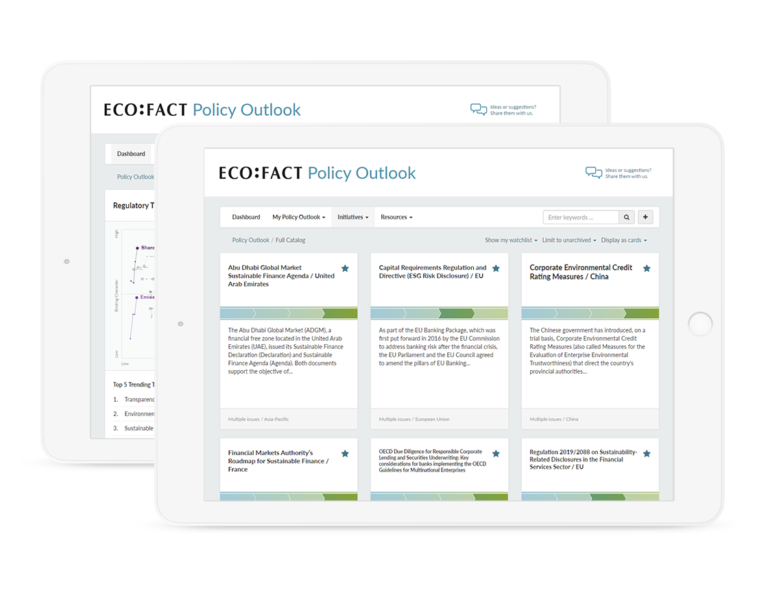Navigating sustainability reporting standards and frameworks
Is it possible that 2023 will go down in history as the year that sustainability reporting hit its stride? Considering the traction that sustainability issues have with regulators and companies around the world, standards for reporting on these issues were expected…eventually. What has taken many by surprise is their rapid proliferation. These standards can improve the quality and comparability of sustainability reporting, but they also increase reporting challenges and complexity.
While the collaborative effort to interlink these standards has been extraordinary, the sheer abundance of standards has left many wondering how they interact and which ones should be used. ECOFACT recently invited its Policy Outlook clients to a webinar on the latest developments in non-financial reporting, as it is increasingly part of the regulatory landscape companies must navigate.
Collaboration and interoperability
During ECOFACT’s webinar, the commonalities and divergences between sustainability reporting standards were explained. We looked at the sustainability disclosure standards released by the IFRS Foundation’s International Sustainability Standards Board (ISSB), the standards of the Global Reporting Initiative (GRI), the European Sustainability Reporting Standards (ESRS), and the reporting framework of the Task Force on Climate-related Financial Disclosures (TCFD).
In general, there is a high degree of interoperability between these standards (see Figure 1). Here are some noteworthy highlights:
- ESG vs. climate focus: while the GRI standards and the ESRS require disclosure on environmental, social, and governance (ESG) topics, the ISSB and the TCFD recommendations mainly focus on climate-related disclosures.
- Frontrunner: currently, the ESRS are the most sophisticated sustainability reporting standards as, among other requirements, companies are required to conduct financial and impact materiality assessments (i.e. double materiality) and must have their sustainability disclosures audited by an independent third party.
- Common origins: the ISSB, GRI, and EU have collaborated in various combinations to develop their standards. All of their standards are aligned with the TCFD recommendations.
- Contingency plan: those using the ISSB standards can consider the GRI standards and the ESRS if there is a sustainability-related risk or opportunity that is not covered by the ISSB.
- Equivalence: companies reporting under the ESRS are considered to be aligned with the GRI standards.

Figure 1. Comparison of key international standards for sustainability disclosures
The European Union’s approach to sustainability reporting
The European Union’s sustainability reporting landscape is evolving, driven by the Directive on Corporate Sustainability Reporting (CSRD). This directive requires businesses to disclose ESG-related information that has either financial or impact materiality for their operations (i.e. double-materiality considerations).
Entities in scope of the CSRD must issue an annual sustainability report that aligns with the ESRS; this aims to ensure companies’ sustainability reporting is comparable, accurate, understandable, relevant, representative, and verifiable. At the end of July 2023, a delegated act detailing the first 12 sector-agnostic ESRS was adopted by the EU Commission and passed to Parliament and Council for consideration.
Main characteristics of the first 12 ESRS
Figure 2 shows the EU’s ESRS include both cross-cutting (2 standards) and topical standards (environmental (five standards), social (four standards), and governance (1 standard)). The EU Commission has incorporated the following into the ESRS:
- Materiality assessment: entities subject to the CSRD must perform a robust materiality assessment and report on all matters that are deemed to have impact and/or financial implications. The methodology used to assess materiality must also be disclosed.
- Phase-in provisions: entities in scope of the CSRD, particularly smaller entities, have been given additional time to set up data collection and reporting procedures. The first set of ESRS includes the option for some entities to defer certain reporting requirements for one, two, or three years, depending on the requirement.
- Value chain reporting: the ESRS compel entities to be transparent about their own operations and value chains. The sustainability report must have information on material impacts, risks, and opportunities in an entity’s operations and in the operations of its upstream and downstream value chain.

Figure 2. Overview of the first 12 European Sustainability Reporting Standards (ESRS) and their breakdown by topic
Tips and key considerations for reporting under multiple standards
As companies may have to disclose under several standards simultaneously, it is crucial they streamline internal processes to ensure their sustainability reporting is consistent and transparent. Not only will this help companies satisfy the regulatory requirements of different jurisdictions, but it will also be easier for investors and other stakeholders to assess sustainability performance and compare companies on a global scale.
Here are some tips on how to approach sustainability reporting under multiple standards:
- Leverage and adapt: look at your current sustainability disclosures to identify areas that simply need modification to align with another standard.
- Harmonize definitions and procedures: ensure your organization uses consistent terminology and procedures throughout its sustainability reporting.
- Assess materiality: determine whether financial materiality, impact materiality, or double materiality should be considered.
- Identify and evaluate gaps: locate and assess areas where your sustainability reporting may fall short of expectations or industry standards.
- Define assurance: depending on regulatory requirements, determine the appropriate level of assurance for your sustainability report (no assurance / limited assurance / reasonable assurance).
- Revise the report: consider revising the structure or layout of your existing sustainability report to align it with the standard you must (or choose to) follow.
- Revise scope: reevaluate the extent of your reporting coverage and check whether you must include the entire value chain or just specific aspects of the supply chain.
- Check for equivalence: the standard you are required to follow may consider reporting under a different standard to also satisfy requirements.
Learn more about Policy Outlook and find out how you can become a subscriber.
 All posts
All posts Contact
Contact



